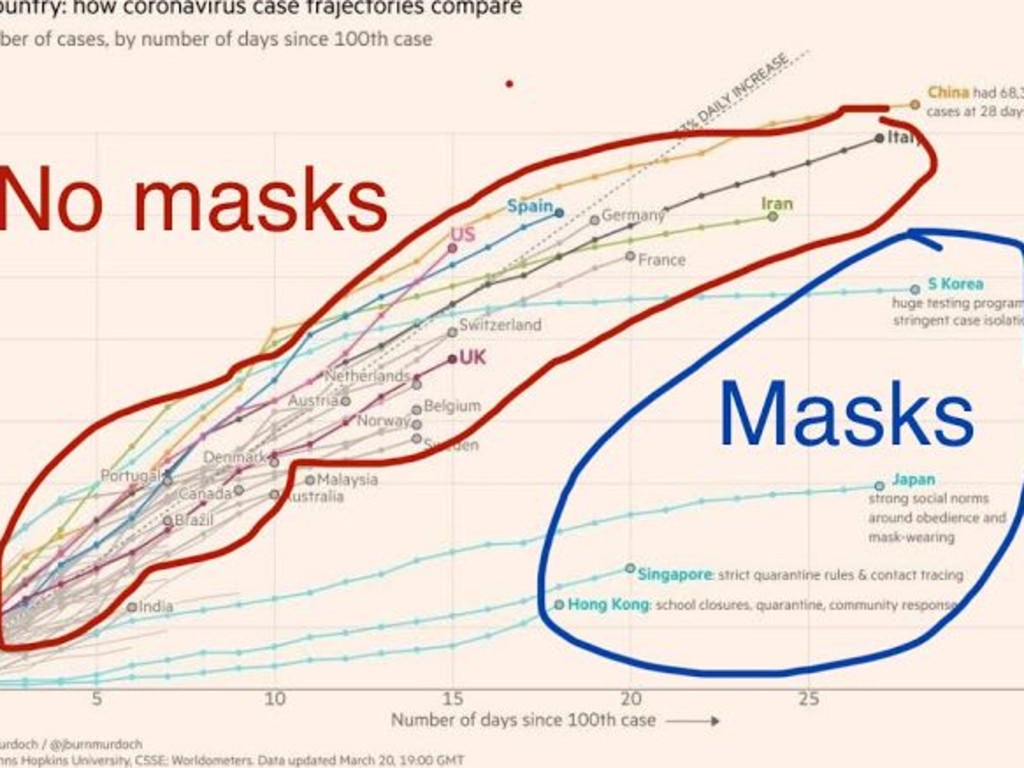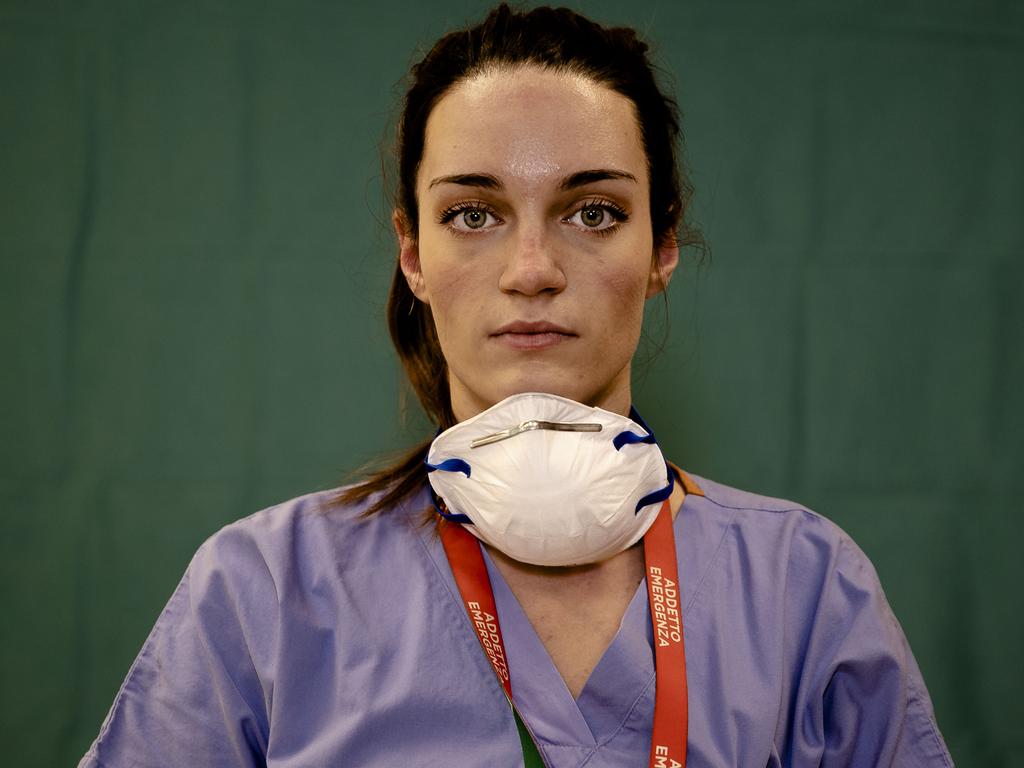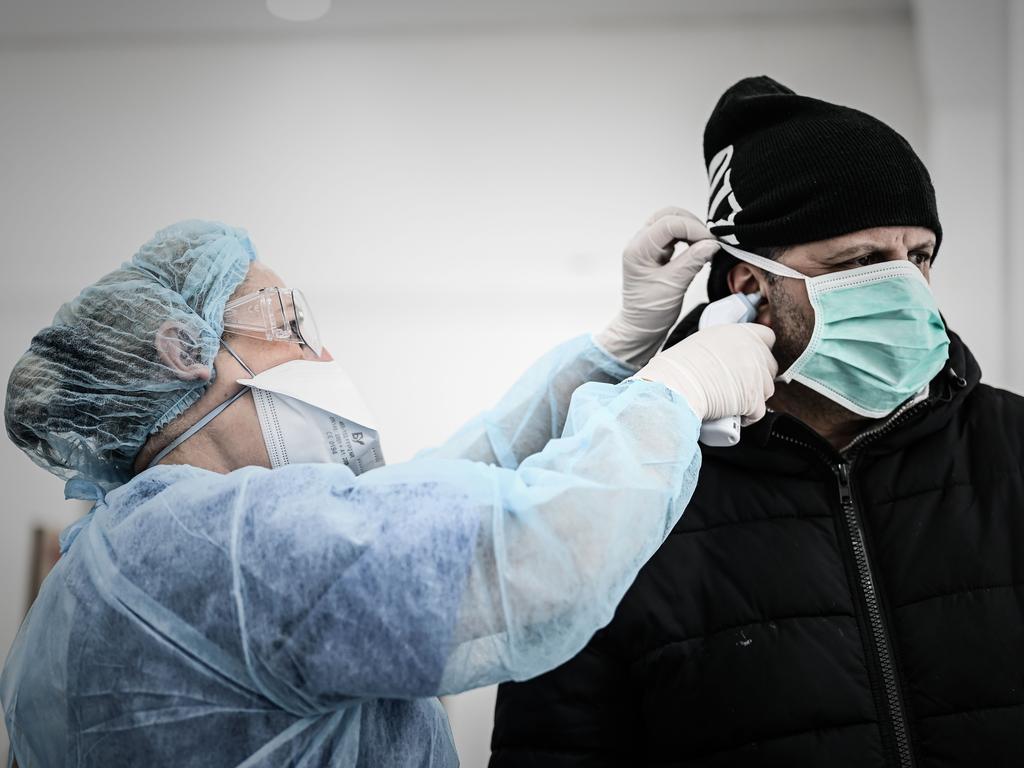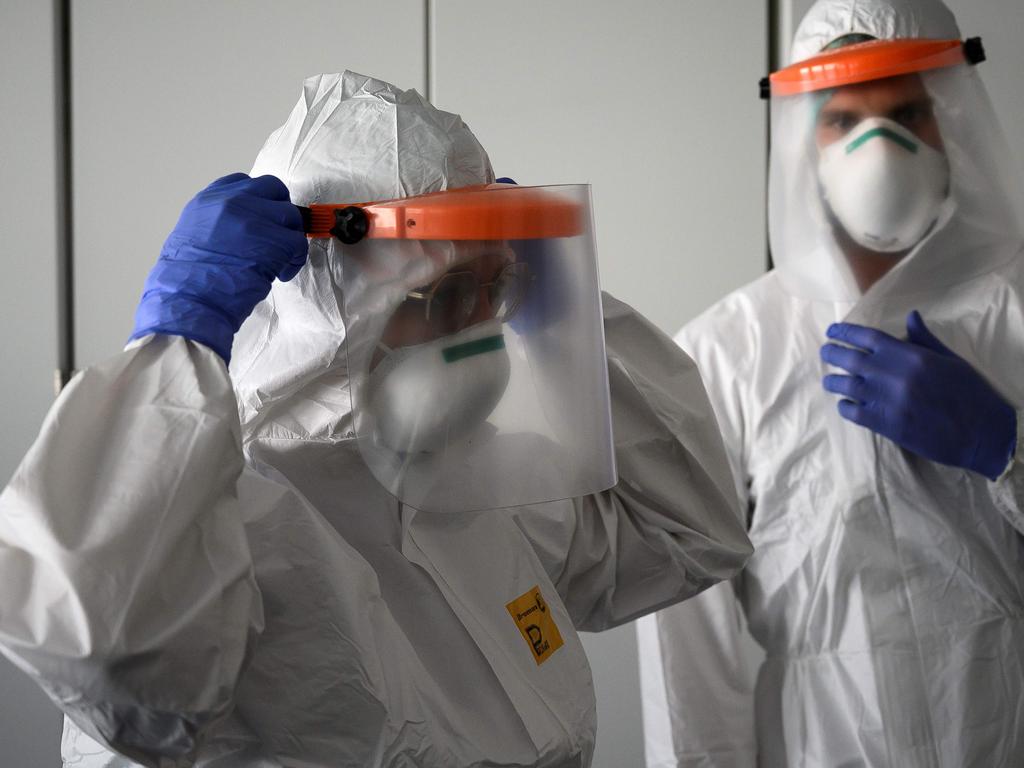Coronavirus: Why wearing masks to prevent virus is dangerous
A new graph has gone viral, claiming widespread use of masks is the “silver bullet” in the fight against COVID-19 – but it’s ignoring one key fact.
No, masks won’t save you from COVID-19.
A sharpie-marked chart has gone viral on social media but the problem is the inference it makes won’t make any difference against the real thing.
In desperate times, it’s natural to yearn for a “quick fix” — like that offered by the #Masks4All social media storm.

At first glance, it seems to make sense. Yes, those nations circled in blue ink are easily associated with mask-wearing cultures.
But, wait: Sharpie marks on charts have caused problems before.
Is there more to it?
China also has a mask-wearing culture so why didn’t it work there? And we’ve heard plenty about the extensive testing and case-tracing campaigns in epidemic veterans Hong Kong and South Korea.
An introduction to causal inference... #epitwitter pic.twitter.com/fqEXtYRTBj
— Allen Cheng (@peripatetical) March 30, 2020
On seeing the viral chart, infection control scientist Dr Holly Seal responded: “Tad simplistic? If we move to community mask use … where are the products coming from? Are members of the public going to wear the same masks over and over again?”
UNSW infectious diseases epidemiologist Dr Abrar Chughtai adds: “We should interpret this carefully. There may be many confounders, (for example) testing, rapid response …”
RELATED: Follow the latest coronavirus updates
RELATED: National tally: Coronavirus cases in Australia

MASKING REALITY
When it comes to this coronavirus, there is no “silver bullet”.
Wearing masks may seem a no-brainer but they are only truly effective when used – with brains.
The advice of epidemiologists and doctors may seem counterintuitive but it’s based on cold, hard maths.
My babies are too young to read this now. And they’d barely recognize me in my gear. But if they lose me to COVID I want them to know Mommy tried really hard to do her job. #GetMePPE #NYC pic.twitter.com/OMew5G7mjK
— Cornelia Griggs (@CorneliaLG) March 29, 2020
N95 medical masks are in short supply. And every medical-grade mask is a non-reusable resource. So they need to be used where they make a real difference – not just self-reassurance.
In a hospital or paramedic setting, they’re part of a complete personal protection kit. In a public setting, they’re at best incomplete – and at worst dangerous.
“The value of masks might not be so much to protect the person wearing them but to protect others,” writes infectious diseases expert Professor Peter Collignon of the ANU.
“If you wear a mask and cough then your droplets won’t go very far. If asymptomatic cause spread, masks may decrease them touching their own nose etc and then surfaces with hand.”
RELATED: What is social distancing?
RELATED: Should you stop taking public transport?

Which is why masks need to be available to give to those known to be infected and even here, they must be used correctly.
“If you watch community mask use, you quickly notice that there are great variations in use … and plenty of people touching the mask, not washing hands and then touching the environment,” Dr Seale adds. “This practice won’t help others.”
Are you using a face mask properly? What about your gloves? 😷🧤@UNSW Medicine's Dr @hollyseale warns of the risks to people misusing protection in the middle of the coronavirus epidemic, to @abcnews @bevvo14.pic.twitter.com/FgcCqFaZHz
— UNSW Medicine (@UNSWMedicine) March 31, 2020
It’s not that widespread mask use is totally worthless. It’s just not the highest-value use of this critical resource at this time. If sufficient supplies of N95 masks are eventually secured, widespread distribution will help put the final nail in COVID-19’s coffin.
“After many reports of asymptomatic transmission, I think community mask use might have some value. It may prevent spreading infections from asymptomatic cases,” says Dr Chughtai.
Masks are only a small part of the equation because COVID-19 is also found on surfaces – particularly of metal or plastic. It’s in faeces, so it can get under your fingernails once you’ve been to the toilet. So … wash your hands. Hard and often.
RELATED: Blood types more at risk of infection
RELATED: Can you catch coronavirus twice?

FACING THE TRUTH
Masks really aren’t all that easy. They’re not body armour that stops COVID-19 bullets. And, in the hands of amateurs, they can actually be dangerous.
Boston University epidemiologist Assistant Professor Ellie Murray took to Twitter to detail what goes on.
“Why might masks for all not work?” she asks. “Because masks are actually not that easy to use.
“Virus droplets aren’t like dust. You don’t have to just stop yourself inhaling them from the air. The virus lands *on* your mask, and if you touch the mask with your hand or face, you can be infected.”
Nobel laureate and infectious diseases expert Professor Peter Doherty says the value of widespread mask use has long been disputed.
“Depending on how good a mask it is, it can get kind of wet, you know, dribbles, snot, mucus … all those things that are so important, but we don’t regard as being of great value. And if your mask is wet, for instance, and if it did get contaminated, well then maybe you want to drop it down around your neck or something when you’re out in really clear and open air … You’re at more risk from the mask.
“So I think they’re very important for healthcare workers who are up close. I’m not so sure they’re that important for the rest of us.”
Wondering about the risk of food deliveries during the #COVID19 crisis?
— Australian Academy of Science (@Science_Academy) March 30, 2020
Nobel Laureate @ProfPCDoherty tackles those and many other questions in our latest webcast.
Watch #LatestFromScience at 5:30 AEDT this evening.https://t.co/ZP9O9iIx4j on @YouTube #COVID19aus pic.twitter.com/k5HoxK9P4x
The same applies to gloves and other protective clothing.
“Just because you’re wearing gloves does NOT mean you can touch your face! I’ve been seeing way too much of that!” Dr Murray says.
The Boston University epidemiologist also reaffirms the real value of single-use masks is as part of a comprehensive protective kit for doctors and nurses, and containing the coughs of the infected.
“Masks and gloves are more useful the more often you’re in contact with someone sick (if you use them correctly),” Dr Murray says. “Most people don’t need them yet.”
Once you do: learn how to use them effectively.
Got a cloth mask or some gloves already? Start practicing taking them off.
— Ellie Murray (@EpiEllie) March 30, 2020
A good suggestion from @EpiKelley: put some shaving cream on the outside; remove; see all the places you got the cream. Repeat until you don’t get dirty removing them! pic.twitter.com/WyHvc5S1no
Take the mask off by pulling the strap at the back of your head forward. Don’t touch the mask itself. Wash your hands energetically – both before and after doing this.
Remember: the targeted application of masks is just one sandbag in the wall being built against the COVID-19 tidal wave.
“What else is coming?” Dr Murray asks rhetorically. “You or someone you love is probably going to get sick, maybe hospitalised and maybe die. We need to face that possibility and prepare. Be ready to stay home 14+ days while sick, learn when it’s time go to the hospital. Learn to cope with grief and loss.”
Jamie Seidel is a freelance writer | @JamieSeidel
Originally published as Coronavirus: Why wearing masks to prevent virus is dangerous




